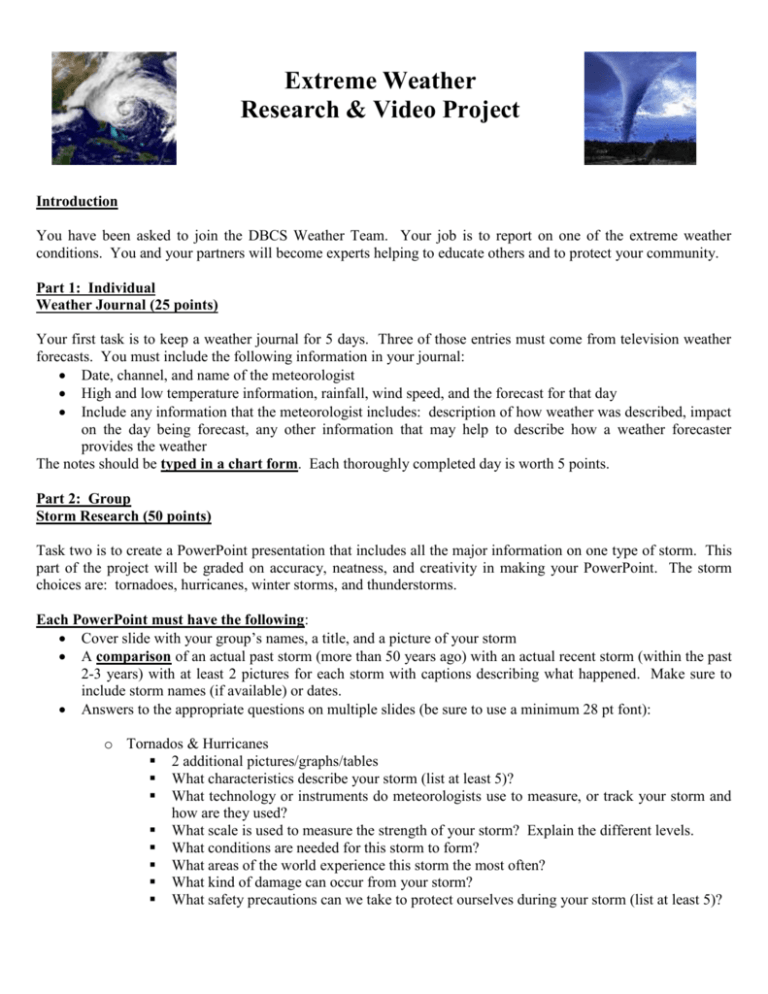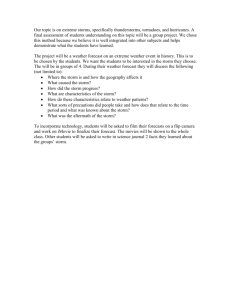Extreme Weather Research & Video Project
advertisement

Extreme Weather Research & Video Project Introduction You have been asked to join the DBCS Weather Team. Your job is to report on one of the extreme weather conditions. You and your partners will become experts helping to educate others and to protect your community. Part 1: Individual Weather Journal (25 points) Your first task is to keep a weather journal for 5 days. Three of those entries must come from television weather forecasts. You must include the following information in your journal: Date, channel, and name of the meteorologist High and low temperature information, rainfall, wind speed, and the forecast for that day Include any information that the meteorologist includes: description of how weather was described, impact on the day being forecast, any other information that may help to describe how a weather forecaster provides the weather The notes should be typed in a chart form. Each thoroughly completed day is worth 5 points. Part 2: Group Storm Research (50 points) Task two is to create a PowerPoint presentation that includes all the major information on one type of storm. This part of the project will be graded on accuracy, neatness, and creativity in making your PowerPoint. The storm choices are: tornadoes, hurricanes, winter storms, and thunderstorms. Each PowerPoint must have the following: Cover slide with your group’s names, a title, and a picture of your storm A comparison of an actual past storm (more than 50 years ago) with an actual recent storm (within the past 2-3 years) with at least 2 pictures for each storm with captions describing what happened. Make sure to include storm names (if available) or dates. Answers to the appropriate questions on multiple slides (be sure to use a minimum 28 pt font): o Tornados & Hurricanes 2 additional pictures/graphs/tables What characteristics describe your storm (list at least 5)? What technology or instruments do meteorologists use to measure, or track your storm and how are they used? What scale is used to measure the strength of your storm? Explain the different levels. What conditions are needed for this storm to form? What areas of the world experience this storm the most often? What kind of damage can occur from your storm? What safety precautions can we take to protect ourselves during your storm (list at least 5)? o Winter Storms 2 additional pictures/graphs/tables What characteristics describe your storm (at least 5)? What technology or instruments do meteorologists use to measure, or track your storm and how are they used? What are the different types of winter storms? What kind of damage can occur from your storm? What safety precautions can we take to protect ourselves during your storm (list at least 10)? o Thunderstorms 2 additional pictures/graphs/tables What characteristics describe your storm? What technology or instruments do meteorologists used to measure, or track your storm and how are they used? How is thunder created? How is lightning created? What conditions are needed for this storm to form? What kind of damage can occur from your storm? What safety precautions can we take to protect ourselves during your storm (at least 5)? Part 3: Group 6-10 minute Weather Forecast Video (25 points) Your final task will be to create a 3 day weather forecast for the evening news. Using maps, graphics, and weather symbols, you and your partners will describe in a 6-10 minute weather report the explanation of your extreme weather condition. You should show the pressure patterns, the position of fronts, areas of precipitation, areas of dangerous weather and patterns. You should be able to take ideas from the meteorologists that you watched for Part 1. Be creative, use costumes, invent names, BUT don’t forget to include the science that causes the weather to occur. Day 1: The storm is coming. Explain the direction the storm will take (radar images). How long it is expected to remain in the area and give advice on what preparations your viewers should take. You can talk about some of the local activities that might be affected by the upcoming weather. Day 2: The storm is here. Explain how the path of the storm may have changed. How much precipitation is expected to fall? What are the wind speeds and direction? What are the high/low temperatures? Has there been any restrictions on travel or a state of emergency? Make sure to include different times of the day. Day 3: The storm has left. Explain which direction the storm went to and what destruction it left behind. Were there any deaths due to the storm? Is the government sending in any assistance? Each member of the group is expected to participate in the video in an equal amount.






